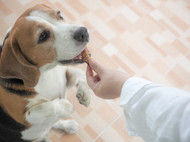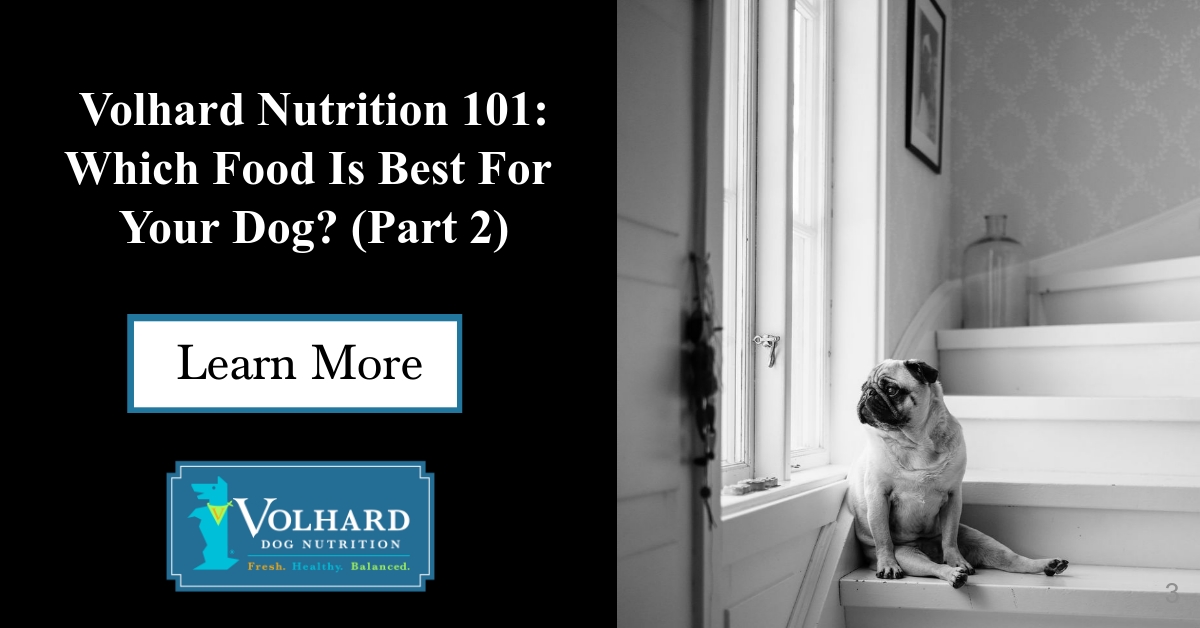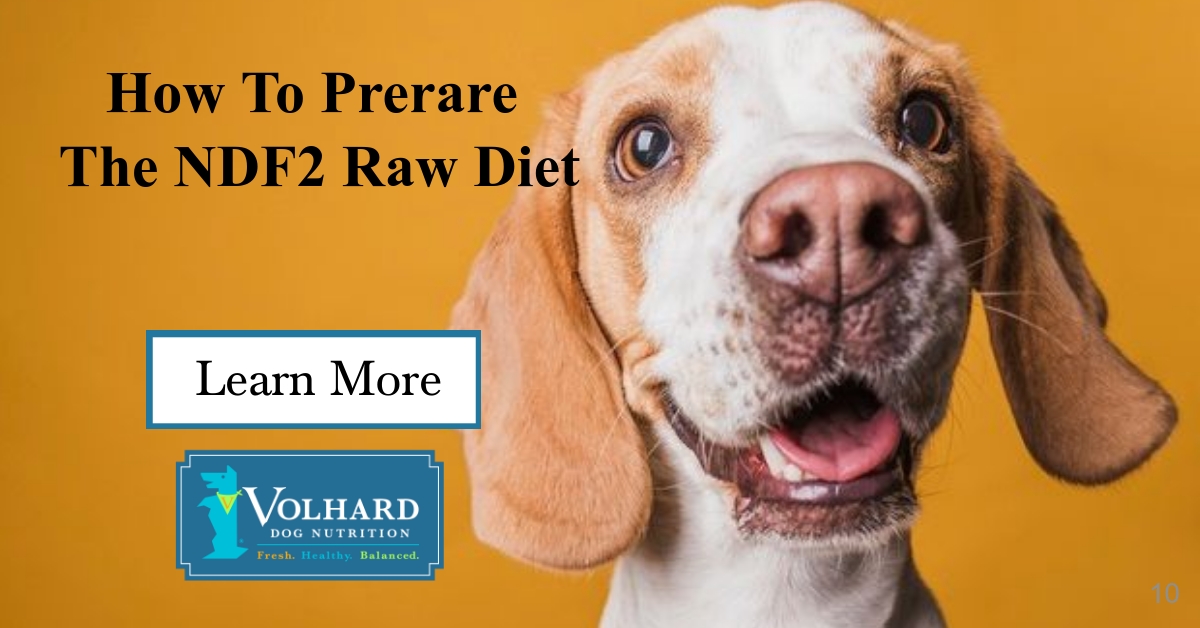Volhard Dog Nutrition 101: Determining Which Food Is Best For Your Dog (Part II)
Posted by Volhard Dog Nutrition on Oct 28th 2020
Last month, we spoke about one crucial step in determining which food is best for your dog: flipping the bag over and reading the ingredients.
One of the best ways of choosing a quality, nutritious diet for your pet is to assess the contents and to hold them to certain standards; this means the package contains actual meat, is not excessively dependent on carbohydrates, has been third-party tested and is upfront about their ingredient sourcing.
Choosing Food for a Specific Dog Breed
Understanding the breed of dog you have is a great asset.
Do you have a high energy dog, a working dog, a sporting dog, a hound dog, herding dog, toy, non-sporting, couch potato? This knowledge about breed and activity level allows you to choose a protein rich food that provides the amount of calories needed to maintain good health and growth in your dog.
What age is your dog? A puppy requires different levels of nutrition than a senior dog. Making sure you choose a food that is appropriate for all life stages is the next important factor.
Genetics play a huge role in the health status of canines, just as with humans, and can be supported or deteriorated by a diet that does not allow for ingredient diversity which can lead to potential health conditions that consistently affect certain dog breeds.
For example, some types of schnauzers are often predisposed to a life with high cholesterol and blood fat levels, Dalmatians often fall victim to bladder or kidney stone formations if eating only dry food, and labradors are highly susceptible to canine obesity if given a diet with 60% carbohydrates and no exercise.
Not only do ingredients matter but whether the food is 100% processed or fresh, the sourcing and whether or not synthetics or whole fresh foods are used.
While researching health conditions that may affect your dog’s breed specifically is a great jumping off point for becoming aware of things to watch out for, it is important to remember that your dog is an individual, with health issues and a medical history that is theirs alone—despite the breed.
For instance, you may have a small dog of any breed that has issues with high levels of cholesterol that is not a schnauzer, but they may thrive better on a diet that is low-fat, low calorie just like a schnauzer might need.
There are commercial diets that have been created using extensive marketing that target different breeds of dogs. These diets—if you actually flip the bag over and read and compare the ingredients—are almost exactly the same and do nothing special for your dog.
Mythbuster: There is no such thing as a breed-specific diet! You are paying for a breed specific diet that is in fact not specific and not nutritional. Stop throwing your money away.
Wade through the marketing and find yourself a fresh, nutritional diet that can be tailored to your dog’s needs.
Remember the dog is the dog...same functioning digestive tract no matter the breed or size. All dogs have the same internal anatomy and physiology and the same nutritional needs despite size and breed. A Shi Tzu has the same elemental nutritional needs as a Great Dane; the only difference is that the Shi Tzu has to eat much less to satisfy those needs. The claims that dogs have different coats and shed differently, or have different bone structure, or produce more or less of coat oils are NOT sufficient to indicate each breed needs a designer food.
Every dog is an individual with unique tastes and reactions to food. What this means is that you can get a breed of dog that does not like chicken, or a dog of northern breeding that dislikes fish, or a German Shepherd that cannot eat lamb because it causes gas. Some Dalmatians (a breed with a particular predisposition toward forming urate stones) do fine with high purine meats, and others can only have low purine meats. This is where the mantra of “feed the dog in front of you” comes into play.
Feed your dog a fresh, natural, biologically appropriate diet and adjust your ingredients as needed. If the dog gets sick of turkey, then cut back on the turkey and feed more of something else. If your dog does not do well with beef, then do not feed as much beef (or any, if you like). Once your dog has started and adjusted to a natural diet, start adding more and more variety in. Over time you will learn the ins and outs of your dog's feeding habits, that perhaps rabbit is not your dog's favorite but that she really likes pork.
Overall, it is more important to consider the nutritional contents of the diet you choose for your canine, rather than the claims the packaging is making about breed specificity. For example, the latest fad used by certain manufacturers is the idea that diets for specific breeds should contain ingredients that apparently are from the same location that the breed originated. But it is absolutely not true that because your Irish Setter’s ancestors came from Ireland, your dog needs a diet that is based off of potatoes and lamb, since those are some of the most commonly consumed foods in Ireland.
What about mixed-breed dogs? If dogs have "evolved" in that short time period to eat only the foods from the regions in which they were developed, then what do you feed a dog that has a variety of different dogs contained in its heritage? Most of the time people can only guess what breeds of dogs contributed to their loving pet, and if dogs had to be fed a designer diet, they would be at a loss for what to feed it. Thankfully, canine heritage and nature herself point to the proper answer: feed a fresh, natural diet.
Essentially, basing your dog’s dietary needs off of their breed is a wonderful place to start, but at the end of the day focus on not feeding a 100% processed diet. Make sure the diet you choose is calorically dense and exceeds the necessary requirements for your dog to stay alive for more than one day. Employ a fresh, natural diet that is hydrated and can provide a balanced nutritional meal no matter the breed, age, sex, and activity level. Better yet, choose a diet like Volhard which is a fresh diet that has chosen ingredients that help every dog thrive and which can be adjusted to meet the caloric needs of your dog just like your food that you eat. You need (X) many calories in a day based on your weight and activity level to balance the amount of calories you are expending. That is how it is done!
Don't wait until your furry friend's dental issues become painful or severe. Take proactive steps to maintain your dog's dental health by feeding them a natural diet!
For more advice on dog nutrition, health, and training, contact us and check out our blog!
Volhard Dog Nutrition and its expert canine nutrition coaches are now offering online consultations to help more dog parents discover why and how to feed their dogs the healthiest of foods!
Speaking to a Volhard canine nutrition coach will help you understand the inseparable relationship between healthy food, a healthy body, and a healthy mind.
If you want to contact one of our Volhard canine nutrition coaches, don't hesitate to access our consultation page!



